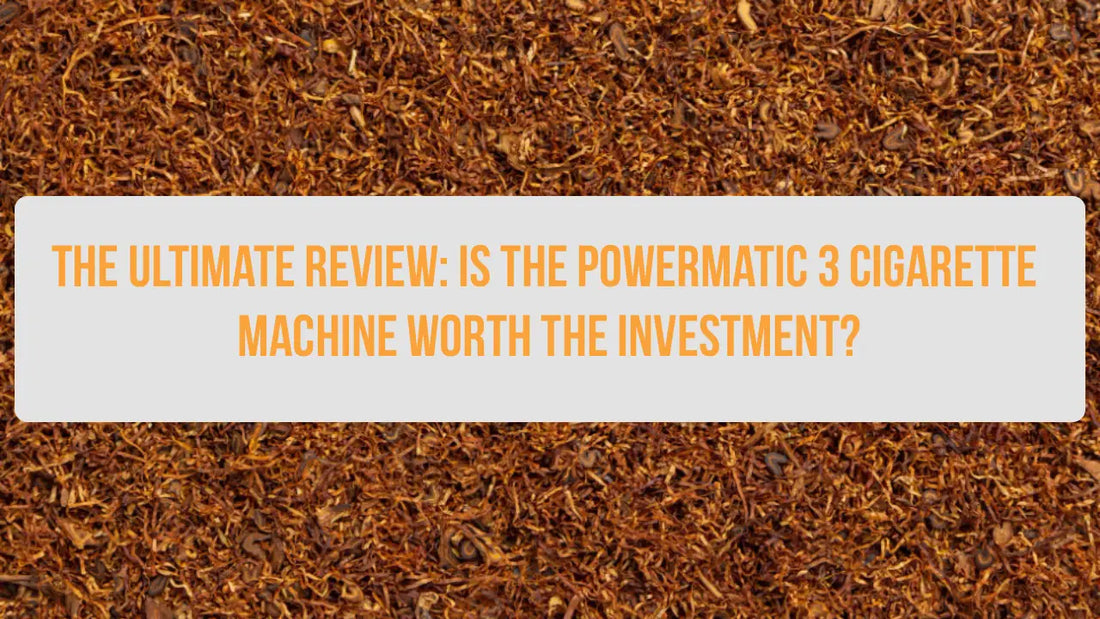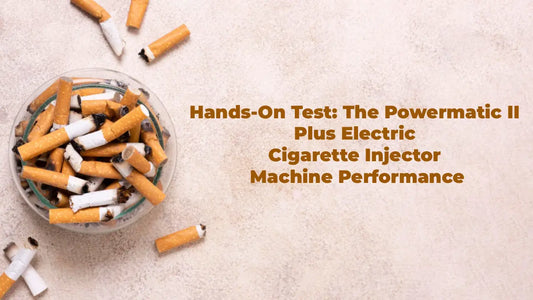
The Ultimate Review: Is the Powermatic 3 Cigarette Machine Worth the Investment?
Share
The Ultimate Review: Is the Powermatic 3 Cigarette Machine Worth the Investment?
Introduction: The Economics of the Modern Smoker
In an age where the cost of commercial cigarettes seems to climb with every passing year, the financial burden on the average smoker is heavier than ever. Many have sought refuge in the "Roll-Your-Own" (RYO) movement, recognizing the potential for substantial savings and greater control over their tobacco. However, the manual process—slow, messy, and inconsistent—often leads to frustration and a return to the convenience of store-bought packs.
Enter the Powermatic 3 (III) Electric Cigarette Machine. Dubbed by many as the "McLaren of rolling machines," this device promises to bridge the gap between the cost savings of RYO and the effortless convenience of a factory-made cigarette. It's a significant investment, often costing several times more than its manual and semi-electric counterparts, which naturally leads to the ultimate question: Is the Powermatic 3 worth the investment?
This is not a simple question to answer, as the value proposition depends entirely on your smoking habits, your budget, and your tolerance for technical finickiness. Over the next two thousand words, we will conduct an exhaustive, in-depth review of the Powermatic 3, dissecting its advanced technology, analyzing its real-world performance, and calculating the true return on investment to help you decide if this machine deserves a permanent spot on your countertop.
Chapter 1: Unboxing the Future—Features and Specifications
The Powermatic 3 is a departure from the crank-operated manual injectors and the single-serve electric models (like its venerable sibling, the Powermatic 2). The Powermatic line of products includes a variety of machines to suit different needs, from manual to fully automatic options. The Powermatic 3 presents itself as a semi-automatic, high-volume machine, designed for the serious, high-frequency RYO user. While the Powermatic 3 is constructed specifically for tobacco use, it is not intended for use with metal or plastics, as doing so may void the warranty and affect the machine's longevity.
The Core Technological Leap: Automation and Digital Control
The primary feature that elevates the Powermatic 3 above nearly all competitors is its fully automated injection process. This is not a machine where you manually push a lever or hold a button while the tobacco is packed.
With user-selectable density settings, you can tailor each batch to your preference. Be sure to check your preferred settings before starting a batch, as the outcome varies depending on the type of tobacco and the selected density setting.
1. One-Button Operation: True Convenience
The process is streamlined to three simple steps:
- Fill the large tobacco hopper.
- Slide a cigarette tube onto the nozzle.
- Press the Start button.
From there, the machine takes over. It automatically measures, compresses, and injects the precise amount of tobacco into the tube before a cutter cleanly severs the excess. This hands-off approach drastically reduces the time and effort required to produce a full pack or carton.
2. The High-Capacity Hopper
The machine features a generous tobacco hopper capable of holding enough loose tobacco for approximately 30 to 32 King Size cigarettes (about a pack and a half). This capacity allows the user to pre-load a substantial amount of tobacco and run a continuous batch without stopping every few minutes, which is a significant time-saver over the Powermatic 2’s single-serve loading tray.
3. Digital Display and Density Selection
The internal workings of the Powermatic 3 are governed by an internal computer chip, a feature rarely seen in this class of injector. This computer controls and monitors the process, displaying key information on a small digital screen.
- Cigarette Counter: This tracks the total number of cigarettes made since the machine was last reset, allowing you to monitor production and, crucially, track the machine's long-term durability. Some veteran users report counters well into the tens of thousands before the machine needs a major repair or replacement.
- Density Settings: The digital control allows you to select your preferred tobacco density. Whether you prefer a looser, faster-burning cigarette or a tightly-packed, slow-burning smoke, the Powermatic 3 offers user-selectable density settings. This is a powerful customization tool that directly impacts the final quality and feel of your smoke.
4. Automatic Jam Protection
An intelligent electronic sensor system monitors the injection process. If it detects a jam—most often caused by improper tobacco moisture or a crushed tube—it will halt the process and flash an error code on the display. If the injection path becomes blocked, the machine will stop and display an error code, prompting the user to clear the blockage before continuing. This is a vital feature for protecting the delicate internal motor and injection mechanism from damage, which is a common failure point in less-sophisticated electric rollers.
|
Feature |
Powermatic 3 (III) |
Powermatic 2 (II) |
Advantage |
|---|---|---|---|
|
Operation |
Fully Automatic (Push-Button) |
Semi-Electric (Handle-Operated) |
Hands-free and more consistent. |
|
Tobacco Capacity |
Large Hopper (30+ cigarettes) |
Single-Serve Tray (1 cigarette) |
Allows for continuous batch rolling. |
|
Control |
Digital Display & Density Settings |
Analog/Manual |
Precise customization and tracking. |
|
Injection System |
Spoon/Titanium-Plated Compressor |
Spoon/Titanium-Plated Compressor |
Both use the superior Spoon method. |
|
Portability |
Lower (Larger/Heavier at ≈7 lbs) |
Higher (Smaller/Lighter at ≈2.25 lbs) |
PM3 is a countertop fixture. |
Chapter 2: The Proof is in the Smoke—Performance and Consistency
The core metric for judging any cigarette machine is the quality of the final product. A poorly-rolled cigarette—too loose, filled with "duff" (pulverized tobacco), or with a "cherry drop" (tobacco falling out the end)—defeats the entire purpose of RYO.
The Spoon Injection Advantage
The Powermatic line, including the PM3, utilizes a spoon-style injector as opposed to the cheaper, less reliable auger (or coil) injectors.
-
Spoon Injection: This method works by collecting a measured dose of tobacco, compressing it slightly, and then using a clean-sweeping motion—like a spoon—to push the tobacco uniformly into the tube. This process is gentle and preserves the tobacco strands, leading to a much better, more uniform pack.
-
Auger/Coil Injection: This method spins a coil of wire to draw the tobacco into the tube. This method tends to shred the tobacco into fine dust (duff), which burns too quickly and can fall out, leading to a drastically inferior cigarette.
The PM3’s precision-engineered spoon and titanium-plated compressor ensure that the injection is consistent from one cigarette to the next. The result is a smoke that is virtually indistinguishable from a commercial, store-bought cigarette, with a firm feel, a clean filter end, and an even burn.
Speed vs. Consistency: The Efficiency Debate
For most users, the PM3 offers a significant speed advantage. Once the hopper is loaded, many users report being able to produce a full carton (200 cigarettes) in as little as 30-45 minutes of focused work. When you factor in the time saved not having to reload a single-serve tray 200 times, the efficiency gain is undeniable.
However, the automated nature introduces a new dependency: tobacco quality.
The Tobacco Goldilocks Zone:
The most consistent and recurring criticism of the Powermatic 3 is its finickiness with tobacco. It requires a specific, narrow range of tobacco cut and moisture content to function flawlessly.
-
Cut: The machine works best with volume tobacco (also known as "chop cut" or "shag cut"), which is specifically processed for RYO machines. It struggles with fine-cut or pipe-cut tobacco.
-
Moisture: This is the most crucial factor. Tobacco that is too dry can crumble, leading to an inconsistent pack or machine errors. Tobacco that is too moist or "roll tobacco" (common for hand-rolling) will clog the injection chamber, trigger the jam-protection system, or cause "hopper errors." Many experienced users learn to "buffer" or "fluff" their tobacco and ensure it has an optimal 14-15% moisture content before use.
In short: when the tobacco is perfect, the Powermatic 3 is a flawless, high-speed machine. When the tobacco is slightly off, its automation can become its biggest weakness, requiring manual intervention to clear errors.
The 100s Challenge
Another common note from users is the machine's handling of 100mm tubes. While the machine is advertised to work with both King Size and 100s, many find that 100s tubes are not filled perfectly to the filter end, often requiring a little manual "tamping" down to achieve a firm pack. King Size tubes, on the other hand, are almost universally praised for a flawless, factory-quality fill.
Chapter 3: The Investment Justification—Calculating the ROI
At its core, the argument for the Powermatic 3 hinges on its ability to save you money in the long run. The initial cost is substantial, often retailing between $200 and $350 USD. This immediately puts off many casual users. So, when does the investment pay off? It's important to note your purchase date, as this not only establishes your warranty coverage but also helps you track your return on investment over time.
The Financial Math
Let’s run a conservative financial analysis for a typical “Pack-A-Day” smoker in a high-tax region (note: these figures are illustrative and depend heavily on local taxes and tobacco prices).
|
Item |
Commercial Cigarettes (Per Year) |
Roll-Your-Own (RYO) with PM3 (Per Year) |
|---|---|---|
|
Cost Per Pack |
≈$10.00 |
≈$1.50 (Tobacco + Tube Cost) |
|
Packs Per Year |
365 |
365 |
|
Annual Cost of Cigarettes |
$3,650.00 |
$547.50 |
|
Machine Cost (One-Time) |
$0.00 |
≈$300.00 |
|
Total First-Year Expenditure |
$3,650.00 |
$847.50 |
|
Annual Savings (Year 1) |
- |
$2,802.50 |
Based on this typical calculation, the Powermatic 3 pays for itself in just over one month of smoking. The financial savings are astronomical.
-
Year 2 and Beyond: After the first year, your pure savings continue at the rate of approximately $3,100 per year. The longevity of the machine is impressive, with many users reporting over 50,000 cigarettes (the equivalent of 2,500 packs or almost 7 years of smoking) before needing any major maintenance.
When considering the machine cost, keep in mind that warranty coverage typically begins from the date of delivery to the customer, ensuring protection starts as soon as you receive your device.
The verdict on the investment is clear: From a purely financial perspective, the Powermatic 3 is absolutely worth the money for any regular smoker. The investment is quickly recouped, and the machine transforms from an expense into a powerful, money-saving tool.
Chapter 4: The Voice of the User—Pros and Cons from the Trenches
A machine can look great on a spec sheet, but its true test is in the hands of the everyday user. The aggregated user feedback for the Powermatic 3 is overwhelmingly positive, yet a handful of key complaints prevent it from achieving true five-star perfection.
The Consensus: Where the PM3 Excels (The Pros)
1. Unmatched Consistency and Quality
The most celebrated aspect is the sheer quality of the finished cigarette. Users frequently mention that the cigarettes are packed perfectly from the tip to the filter, a level of consistency that few, if any, other RYO machines can match, regardless of price.
2. The "Walk-Away" Convenience (Semi-Automatic)
For anyone who has suffered through the hand-cranking of a manual machine, the simple push-button operation is a revelation. The ability to load the hopper, press the button, and walk away (for a minute or two) while it works is a game-changer for high-volume production. This feature is particularly praised by smokers with physical disabilities or joint pain, who find the manual action of other machines painful.
3. Durability and Longevity
The machine is built with a sturdy aluminum alloy frame and engineered components. Compared to cheaper, all-plastic machines, the PM3 feels robust and durable. The common refrain from long-time users is, “My last Powermatic made over 22,000 cigarettes, and I expect this one to do the same.” The 1-Year, 20,000-Cigarette Warranty offers a solid baseline of confidence in the machine’s longevity and is subject to the stated terms and conditions provided by the manufacturer.
The Real-World Friction: Common Complaints (The Cons)
1. The Finicky Tobacco Requirement
As discussed, the machine is temperamental. It will expose poor-quality or incorrectly prepared tobacco instantly. This forces the user to invest a little more time in prep, such as using a dedicated tobacco shredder or letting moist tobacco air-dry. For users who want a "set it and forget it" solution with any tobacco they find, this is a major frustration.
2. The Learning Curve
While operation is simple, achieving the perfect cigarette has a learning curve. Users must learn the optimal density setting for their preferred tube and tobacco blend, how to properly “fluff” the tobacco in the hopper, and how to correctly seat the tube. Initial users report a few wasted tubes and some trial-and-error before mastering the device.
If you continue to experience difficulties, completing the manufacturer's online support form with all required information is essential to receive technical assistance.
3. Size and Portability
The Powermatic 3 is a sizable machine, often weighing around 7 pounds. This is significantly heavier and bulkier than the popular Powermatic 2. It is designed to be a dedicated, semi-permanent countertop fixture, not a machine you would easily pack in a suitcase or move between rooms regularly.
Chapter 5: The Powermatic Machines Ecosystem—PM3 vs. the Competition
To fully appreciate the PM3, it’s helpful to understand its place within the broader market, specifically against its own lineage.
For detailed comparisons and additional resources, visit the manufacturer's support page.
Powermatic 2 (PM2): The Classic Workhorse
- The Difference: The PM2 is a semi-electric, single-serve machine. You manually load tobacco, insert the tube, and press a button, but you must manually advance and re-load for every single cigarette.
- The Buyer: The PM2 is the budget-friendly, highly-reliable entry point. It's for the casual or moderate RYO user who values the spoon injection quality but doesn't need the speed or capacity of the PM3.
Powermatic 4 (PM4): The Modernized Middle Ground
- The Difference: The PM4 is a newer electric model that re-introduces the manual lever (like the PM2) but retains an upgraded motor, a smaller body, and a detachable hopper that holds enough tobacco for ≈20 cigarettes. It's often viewed as a PM2 with a turbocharge and a small, semi-automatic hopper.
- The Buyer: The PM4 is for the user who wants some speed improvement over the PM2 and better portability than the PM3, but is willing to sacrifice the full automation and higher capacity of the PM3.
Why Choose the Powermatic 3?
The Powermatic 3 is designed for one specific demographic: the high-volume smoker who demands factory-level quality with the maximum possible automation. If you are a two-pack-a-day smoker, or a household with multiple smokers, the PM3 is the only logical choice in the consumer-grade market. The time saved via its large hopper and one-button operation easily justifies its higher initial cost and larger size over both the PM2 and PM4.
Chapter 6: The Long-Term Commitment—Maintenance and Durability
The phrase “worth the investment” implies long-term performance. Regular cleaning and maintenance steps help protect the machine from premature wear and breakdown. A machine that breaks down after six months is a terrible investment, regardless of the initial savings.
Critical Maintenance and Care
The PM3 is a delicate piece of machinery that must be respected. The primary long-term threat is the buildup of tobacco dust and debris within the injection chamber and the hopper's gears.
-
Regular Cleaning is Non-Negotiable: The machine comes with a cleaning kit (brushes and tools) for a reason. Daily, superficial cleaning (wiping down surfaces, clearing the tray) and weekly deep cleaning (using the brushes to clear the injection path and hopper) are essential. Neglecting this will lead to the "hopper errors" that some users complain about and can eventually damage the motor.
-
Tobacco Management: As noted, using tobacco with the correct moisture content is the best preventative maintenance. Tobacco that is too wet will stick to the internal components and accelerate wear.
The Warranty and Service Factor
Powermatic provides a strong safety net for the investment: a 1-Year, 20,000-Cigarette Limited Warranty. This warranty is often considered industry-leading. For a typical pack-a-day smoker, 20,000 cigarettes represent almost two years of use. If the machine performs flawlessly for that period, the return on investment has been completely realized. This warranty provides a peace of mind that is missing from most cheaper, no-name electric injectors.
Many long-term users, as referenced in customer reviews, report their machines lasting far beyond the warranty, often reaching 50,000, 70,000, and even 80,000 cigarettes. This incredible longevity is the final pillar of the machine's value proposition. The key to reaching these numbers, however, is meticulous adherence to the cleaning and tobacco quality guidelines.
Machine Security: Protecting Your Investment
When you invest in a premium product like the Powermatic 3, security isn’t just about keeping your machine safe from theft—it’s about ensuring your machine, accessories, and the quality of your cigarettes are protected for the long haul. Powermatic machines are designed with robust security features to safeguard your investment and provide peace of mind throughout the product’s lifespan.
The Final Verdict: Is the Powermatic 3 Worth the Investment?
After an exhaustive review of the Powermatic 3’s features, performance, financial metrics, and user feedback, we can deliver a clear, nuanced verdict.
The question of worth depends on which one of the following categories you fall into:
YES, It is Absolutely Worth the Investment if you are a:
- High-Volume Smoker: You smoke a pack or more a day, or are rolling for multiple people. The time saved by the large hopper and automation will quickly justify the machine's price.
- Quality Enthusiast: You demand a commercial-quality cigarette—perfectly packed, no wasted tobacco, and a clean burn. The PM3’s precision spoon injector is unmatched in this category.
- Someone Seeking the Ultimate Convenience: You want the fastest, easiest, most hands-off process possible and are willing to pay a premium for it.
NO, It is NOT Worth the Investment if you are a:
- Budget-Conscious Light Smoker: You only smoke a few cigarettes a day or a pack a week. The machine will take too long to pay for itself, and a cheaper manual or Powermatic 2 would be a more sensible purchase.
- Technophobe or Low-Maintenance User: You are not willing to learn about tobacco moisture, clean the machine regularly, or troubleshoot an occasional error code. The PM3 requires respect for its mechanics.
- A 100s-Only Smoker: While it can make 100s, its performance is demonstrably less flawless than with King Size tubes.
The Powermatic 3 is a premium appliance, not a simple gadget. It is a one-time, significant capital outlay that delivers an exponential return on investment over its multi-year lifespan. It dramatically lowers your monthly expenditure and elevates the quality of the RYO experience to a near-commercial standard.
For the serious, regular roll-your-own smoker, the Powermatic 3 is not just an expense; it is a financial and quality-of-life imperative. It is, without a doubt, the best electric cigarette machine on the market for high-volume, precision rolling, and it earns its title as The Ultimate Investment.







